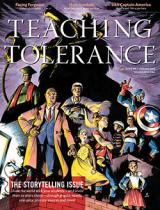New issue of SPLC’s Teaching Tolerance magazine examines power of storytelling to promote social justice
Storytelling can be a powerful classroom tool that helps increase understanding, spark empathy and reduce stress as students tell their own stories and learn from the stories of others.
Storytelling can be a powerful classroom tool that helps increase understanding, spark empathy and reduce stress as students tell their own stories and learn from the stories of others, according to the new issue of Teaching Tolerance magazine.
“I’m proud of every issue of Teaching Tolerance – but this one seems, to me, to embody the essence of Teaching Tolerance more than most,” said Teaching Tolerance Director Maureen Costello. “Storytelling is the closest thing to walking in another’s shoes if you want to see the world from someone else’s point of view. And that is, after all, what we encourage every day.”
The Spring 2015 issue offers educators multiple perspectives on how and why to encourage storytelling. In “Hearing the Lion’s Story,” author Howard Stevenson discusses the racial stress that students of color often feel. To combat this stress, Stevenson encourages teachers to allow children to engage in racial storytelling and to listen to the positive and negative ways their peers experience the realities of their own racial identities.
Using graphic novels to engage students and teach them about people and moments in history that often don’t make it into textbooks is explored in a feature titled “The Social Justice League.” It notes how today’s graphic novels trend toward diverse voices and stories. Even Congressman John Lewis has chosen to use a trilogy of graphic novels to detail his experiences at the forefront of the civil rights movement.
“Behind the Shield” dives into the world of “real-life superhero” and activist Vishavjit Singh who dons a Sikh Captain America costume and shares his own story to dispel myths about Sikhs and broaden young people’s view of what it means to be an American. The artist behind Sikhtoons.com also encourages a new generation of comic book artists to share their stories.
Teaching Tolerance also looks at how the events surrounding the deaths of Michael Brown and others killed by police in the summer and fall of 2014 hold universal lessons worth teaching. Three approaches to thinking and talking about these events that are particularly relevant to educators are examined.
Teaching Tolerance magazine, published three times a year, is the nation’s leading journal serving educators on diversity issues. It is distributed free of charge to more than 410,000 educators nationwide.


